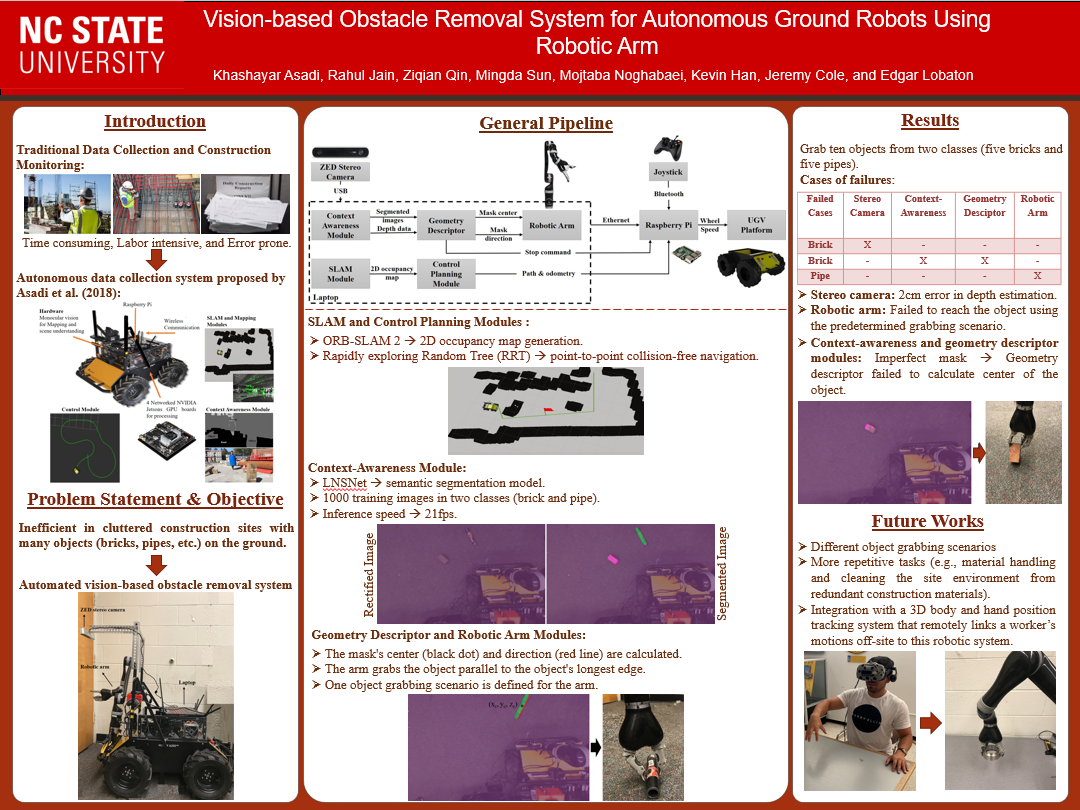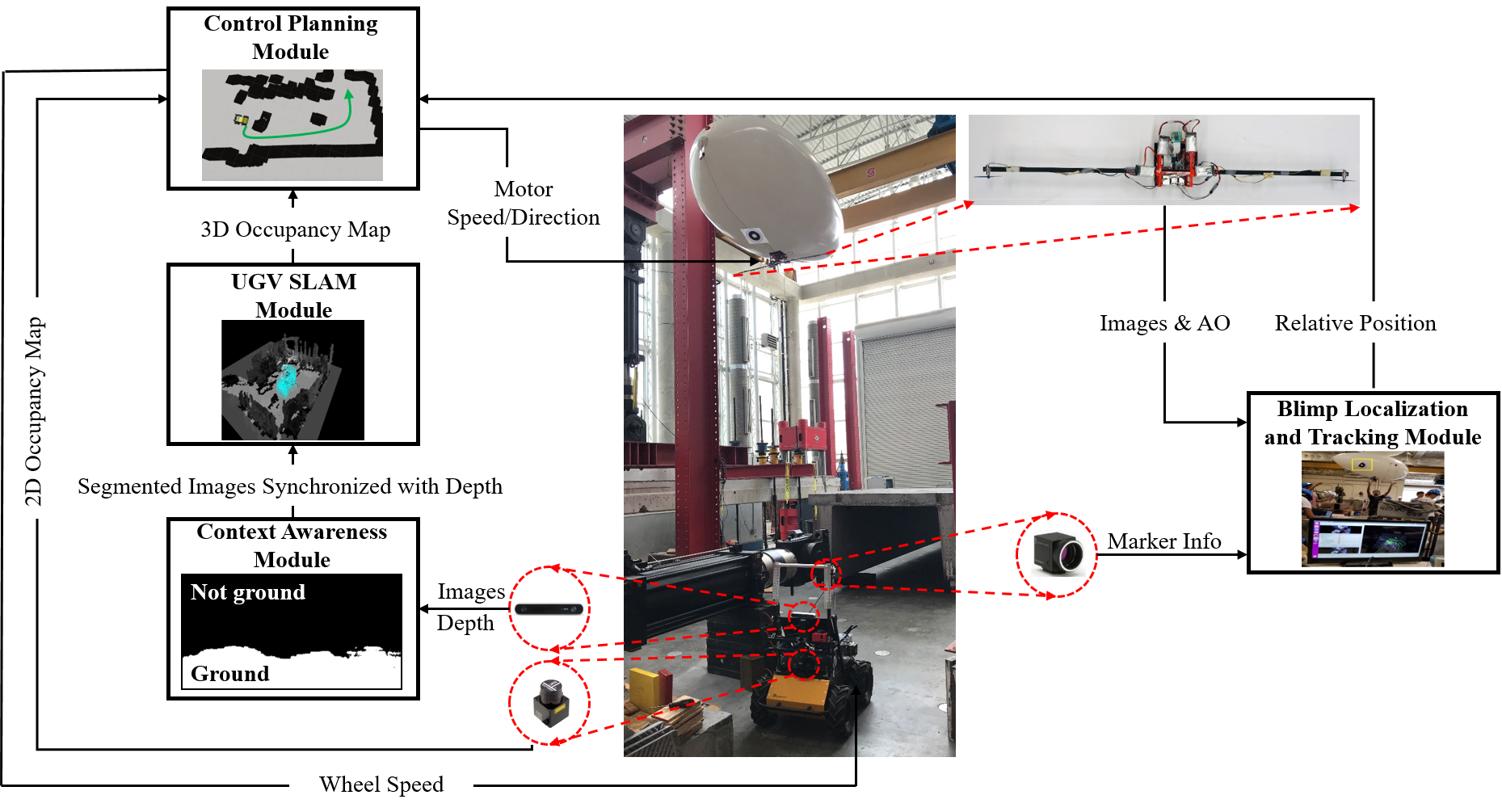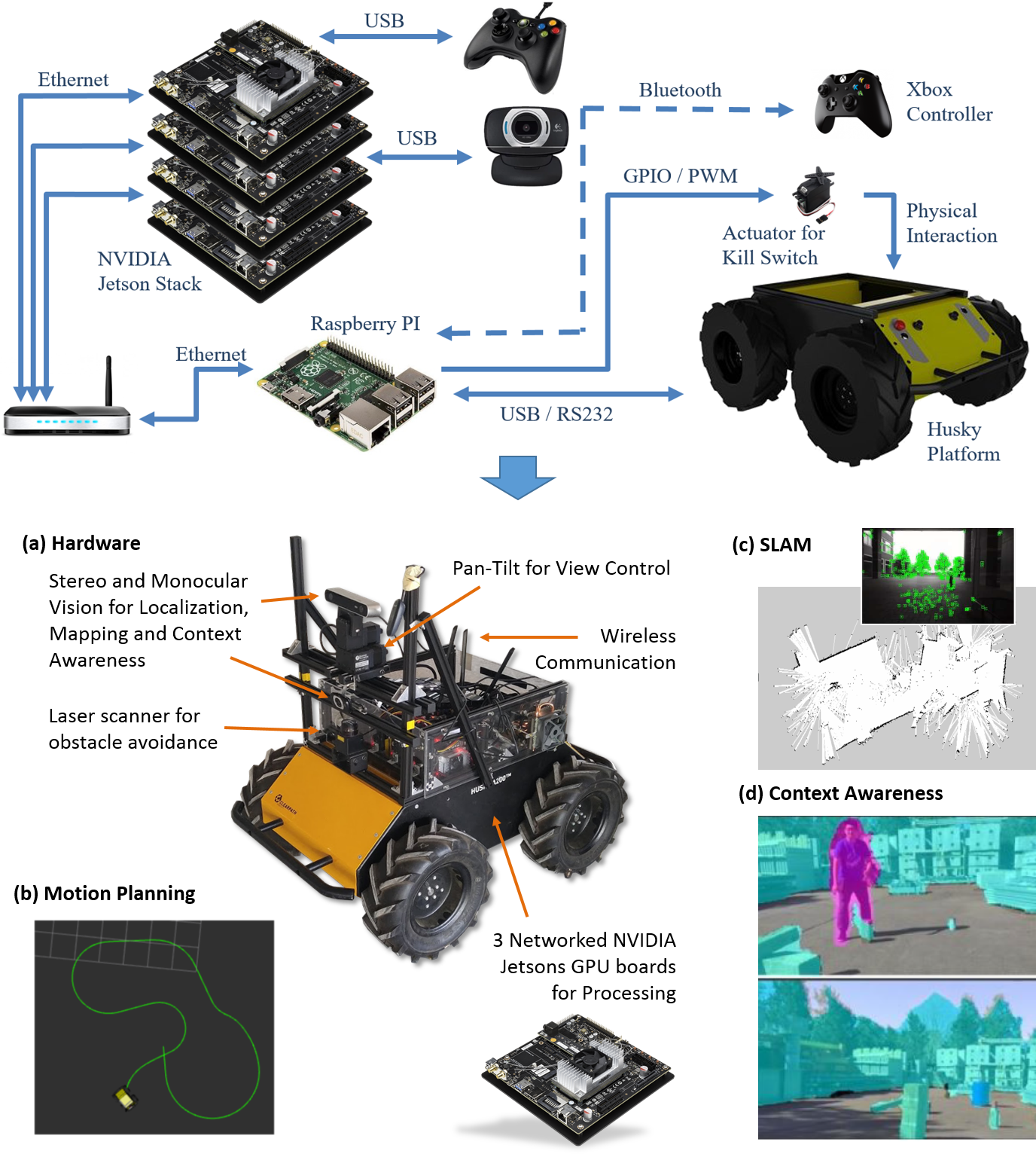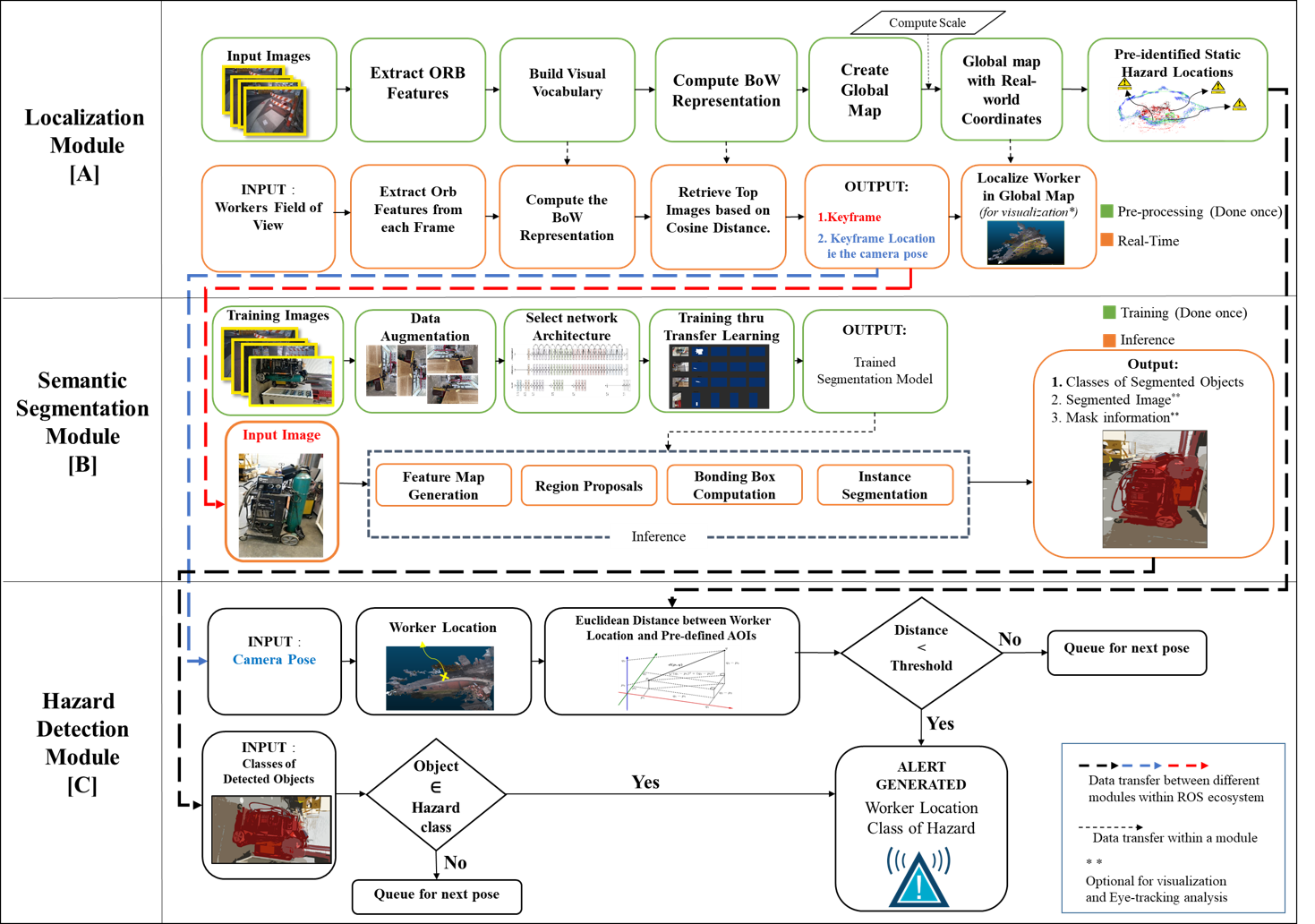The construction industry has become a better planner with the advances in Building Information Modeling (BIM) and IT but we still hear news on megaprojects suffering from cost overrun and delays. Loss in billions of dollars can jeopardize capital projects, endangering the nation’s economic sustainability, which may damage the other two pillars of sustainability - social and environmental. Our research goal is to provide construction project control solutions to these problems through advances in AI (robotics, computer vision, and machine learning) and BIM. Our research partners/sponsors include the Department of Energy, Idaho National Laboratory, National Science Foundation (NSF), NC Department of Transportation (NCDOT), and National Cooperative Highway Research Program (NCHRP).
Autonomy in Construction
Construction sites are environments well known for a wide array of dynamic objects (e.g., workers and equipment) and changing structures, which in turn, challenge automation and autonomy of any nature. We are interested in developing and testing autonomous systems that can provide a global solution to construction productivity, safety, and security. Addressing this research topic enables automation of the subsequent topics below - visual and multimodal data analytics for construction performance monitoring and safety training.Collaborators: Dr. Edgar Lobaton of ECE and Dr. Tianfu (Matt) Wu of ECE.
Asadi, K., Jain, R., Qin, Z., Sun, M., Noghabaei, M., Han, K., Cole, J., and Lobaton, E. (2019). Vision-based Obstacle Removal System for Autonomous Ground Robots Using Robotic Arm. 2019 ASCE International Conference on Computing in Civil Engineering. June 17-19, 2019, Atlanta, GA. [Link]

Asadi, K., Sureshb, A., Ender, E., Gotad, S., Manijar, S., Noghabaei M, Han, K., Lobaton, E., and Wu. T. (Under Review). Building an Integrated UGV-UAV System for Automated Data Collection in Construction. Automation in Construction.

Asadi, K., Bhavsar, U., Kundu, S., Mehta, P., Ramshankar, H., Samadi, S., Suraj, S., Han, K., Lobaton, E., and Wu. T. (2018). Vision-based Integrated Mobile Robotic System for Real-time Applications in Construction. Automation in Construction. Vol. 96, Pg 470-482, [Link]

VR/AR to Support Modular Construction
Modular construction is seen as a potential solution to deal with rising cost and shortage in labor. We are interested in supporting management of modular construction through the use of VR/AR technology. Our research areas include virtual manipulation using a motion sensor and a VR headset, virtual assembly of a modular system, and AR (BIM and as-built models) for QA/QC.Noghabaei, M. and Han. K. (2019). Virtual Manipulation in an Immersive Virtual Environment: Simulation of Virtual Assembly, 2019 ASCE International Conference on Computing in Civil Engineering, Atlanta, GA. Jun. 17-19, 2019. [Link]

Automation in Safety Monitoring and Training
Our main interest is to understand how workers visually perceive safety hazards and characterize human behavior in identifying safety hazards. We use eye-tracking glasses and wearable sensors to capture and estimate physiological and affective states. Through an automated pipeline of capturing and analyzing multimodal sensory data, we can personalize safety monitoring of workers and provide tailored intervention materials to meet individual needs. We are also interested in immersive environments created by 360-degree videos and mixed reality. We can achieve personalized training through captured wearable sensory data, similar to personalized monitoring of workers.Collaborators: Dr. Alex Albert of CCEE, Dr. Edgar Lobaton of ECE, Dr. Tianfu (Matt) Wu of ECE, and Dr. Chang Nam of ISE at NC State.
Noghabaei, M. and Han, K., A. (accepted). Understanding How Construction Workers Recognize Hazards in an Immersive Virtual Environment: Analysis of EEG and Visual Search Patterns. Construction Research Congress 2020, Tempe, AZ, Mar. 8-10.
Jeelani, I., Han, K., and Albert, A. (under review). Development of Vision-based Automated Worker Localization and Real-Time Hazard Detection System for Construction. Journal of Computing in Civil Engineering.

Jeelani, I., Han, K., and Albert, A. (2018). Automating and Scaling Personalized Safety Training Using Eye-tracking Data. Automation in Construction. Vol. 93, pg. 63-77, [Link]

Visual Data Analytics and BIM for Construction Performance Monitoring
We are interested in leveraging visual data (collected via smartphones, mounted action cameras, ground robots, and UAVs) and BIM for construction progress monitoring, condition assessment, and safety. Visual data analytics used in conjunction with BIM allows a seamless and continuous flow of information and therefore quick identification and removal of constraints, allowing a continuous flow of production and elimination of waste. This can be achieved by visualizing and analyzing as-built and as-planned models for assessment of progress, condition, and safety in real-time. Some subtopics include: (1) autonomous indoor and outdoor navigation for data collection using ground robots and UAVs, (2) computer vision-based performance analytics (progress and quality), and (3) ubiquitous visualization through mobile augmented reality for coordination, documentation, and field reporting (progress, quality, and safety).Asadi, K., Ramshankar, H., Noghabaee, M., and Han, K. (2019). Real-Time Image Localization and Registration with BIM Using Perspective Alignment for Indoor Monitoring of Construction. ASCE Journal of Computing in Civil Engineering. [Link]


Han, K., and Golparvar-Fard, M. (2016). Potential of Big Visual Data and Building Information Modeling for Construction Performance Analytics: An Exploratory Study, Automation in Construction. Vol. 73, Pg. 184-198, Link

Han, K., Cline, D., and Golparvar-Fard, M. (2015). Formalized Knowledge of Construction Sequencing for Visual Monitoring of Work-in-Progress via Incomplete Point Clouds and Low-LoD 4D BIMs, Advanced Engineering Informatics. Vol. 29, Issue 4, Pg. 889–901, Link

Han, K., and Golparvar-Fard, M. (2015). Appearance-based Material Classification for Monitoring of Operation-level Construction Progress using 4D BIM and Site Photologs. Automation in Construction.Vol. 53. Pg. 44-47. Link

Project-based Learning in Engineering Courses
Despite efforts to foster teamwork and introduce students to workplace experiences through a class project, typical class structures prevent students from experiencing the holistic nature of professional engineering teamwork. We are interested in bridging the gap between professional engineering work and class projects through new approaches to project-based learning (PBL).Collaborators at NC State: Dr. Cesar Delgado of STEM Education, Dr. Tamecia Jones of STEM Education, Dr. Edgar Lobaton of ECE and Dr. Tianfu (Matt) Wu of ECE. Other collaborators: Dr. Youngjib Ham at Texas A&M and Dr. Hyungchul Yoon at Chungbuk National University.
Delgado, C., Norville, K., Han, K., Lobaton, E., and Wu, T. (2019). Assessing the Effectiveness of Individual Learning in a Realistic Engineering Design Class, 2019 American Society for Engineering Education Southeastern Section Conference, Raleigh, NC. Mar. 10-12, 2019.




